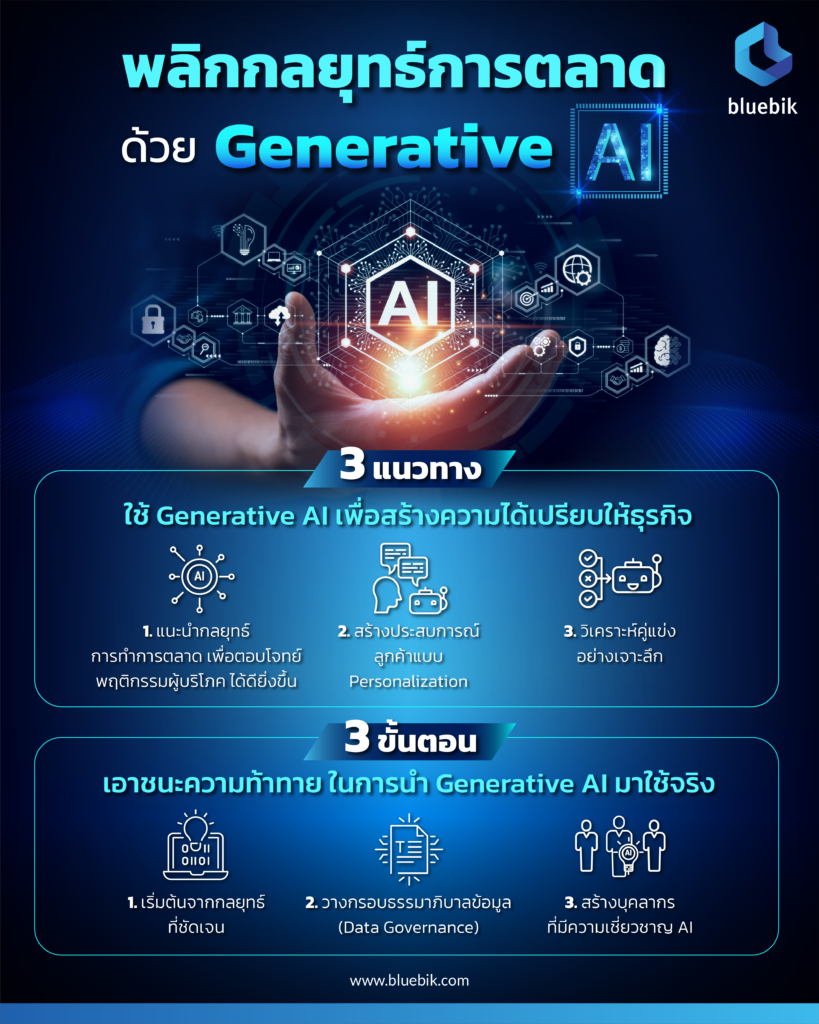Many organizations are using artificial intelligence to drive their business but the key is how to use AI with its maximum efficiency and effectiveness. The question is important especially when it comes to marketing because so many businesses are applying AI-driven tools.
In this special feature, Bluebik would like to recommend the application of generative AI to improve marketing strategies and develop marketing intelligence. It concerns the real-time collection of data relevant to businesses and industries and the analyses of collected data to identify market trends and find insights. It will show what competitors are doing and what customers want. The findings will lead to better strategies, business opportunities and competitive edge.
What marketing benefits does generative AI bring?
Basically AI refers to the smart artificial intelligence technology that can be applied for many purposes including data analyses, image recognition and natural language processing (NLP). Generative AI is the AI that is designed to be capable of generating new things from sets of existing data. For example, it can generate messages, still pictures and motion pictures. ChatGPT, Bard, DALL-E and Midjourney are examples of generative AI technology.
There are three main uses of generative AI for marketing purposes and competitive edge.
1. Recommendations on marketing strategies to better serve consumers
After generative AI is used to study data on new products and services, it can recommend the marketing strategies and create the marketing content that match buying behaviors. With this generative AI application, businesses can foresee the trends of highly demanded products at different periods of time and thus adjust marketing strategies accordingly.
Apart from recommending the marketing strategies that are directly related to consumers’ behaviors, generative AI can also do sentiment analyses to see consumers’ attitudes towards businesses. Generative AI can analyze public reactions to the online content, reviews, pictures and advertising campaigns of brands. Businesses can use findings to improve their communications to make customers have more positive attitudes towards brands. Generative AI can also help protect brand reputations because it tells businesses to avoid the kinds of messages or pictures that will trigger negative feelings.
2. Personalization of customers’ experiences
When business operators know more about groups of customers, they can apply machine learning and generative AI to support personalized marketing. Advertising messages can be designed and promotions can be offered to better serve the demand of individual customers. This can happen when data about customers, the records of their product searches and their past orders for products are processed. By this means, businesses can offer promotions on particular products when targeted customers want to buy them. Businesses can also propose the products that people usually buy together (cross-selling) as well as products or services with more values (up-selling). When customers receive promotions for the products that they want to buy, they will be increasingly stimulated to buy the products or use the services that are promoted. Also, customers will be more satisfied with the products and services that they use.
Apart from recommending products, generative AI also supports customer services through the chatbots that can answer customers’ questions quickly and correctly and increase interactions with customers. For call centers, AI can convert speeches to texts and start processes to solve customers’ problems right away. AI can gather problems, report cases for further analyses and follow up solutions.
3. In-depth analyses of competitors
With the help of generative AI, competitors can be analyzed more thoroughly. When data from various sources are processed and analyzed, business operators have more in-depth information about competitors and can use it to develop strategies. Generative AI facilitates and accelerates searches for information. Conventionally online information is obtained from many sources and later gathered. A technique called “web scraping” is applied to collect data from many websites of competitors and the data are then analyzed.
Besides searching for information, generative AI reports data quickly and thus speeds up the SWOT analysis that concerns strengths and weaknesses. Findings can be used to conduct predictive analysis to predict the new products and services of competitors. Generative AI also helps assess the impacts of new products on overall markets and predict the market shares of different types of products. In addition, generative AI supports strategic decisions because it prioritizes groups of competitors among both direct competitors who sell same products and services and indirect competitors. Generative AI also assesses the degrees of competition in markets.

Challenges facing generative AI applications
Although generative AI can improve efficiency in many areas, its applications have some limitations that business operators should be aware of. For example, answers from ChatGPT are not 100% accurate. There can be wrong answers because ChatGPT generates answers from the data that it received from previous training. The latest data used to train ChatGPT dated from September 2021. To let ChatGPT process new information such as data about products and services of companies, new commands and new and correct data must be input. If incorrect, incomplete or distorted information is fed in, outcomes from generative AI applications will be inaccurate in accordance with the garbage in, garbage out concept. If some models limit the sizes of input and output, there will be constraints on the further applications of data. For example, there may not be enough data for the development of a chatbot to answer customers’ questions or for researches to find in-depth information.
However, Bluebik has basic tips to overcome such challenges.
- Clear strategies
Before implementing an AI application project, business organizations should have their clear purposes of AI applications. Then they can work out relevant use cases. There are two main principles for the design of use cases.
- Top-down – This is to figure out ways to maximize benefits. Main focuses are on the channels, products and services that are profitable and on the causes of customers’ problems.
- Bottom-up – Use case design is based on the existing resources that organizations are using. AI is applied to improve efficiency or solve ongoing issues.
- Data governance
Data governance ensures that the data of organizations are accurate, adequate and consistent. There are policies and processes to maintain the quality and security of data as well as regulatory compliance.
When data are subject to a common standard, wrong output from data analytic models can be prevented. A major challenge facing AI applications is the lack of quality data for use due to the collection of data with different formats and inconsistencies. This blocks AI’s efficiency when it is used to process and analyze data. AI-driven systems need considerable and quality data which AI can learn and process to recommend accurate and precise decisions.
- Production of AI experts
Another serious challenge concerning AI applications is that some organizations do not have adequate and relevant knowledge and expertise. This refers to the lack of data analytic expertise, tools and data and AI personnel. Consequently, such organizations are unable to apply AI with efficiency.
Therefore, organizations should invest in personnel training to increase their knowledge and understanding. They can organize the training together with partners with relevant expertise or send their staff to training with external organizations. In addition, they should allocate resources particularly to AI projects and find external companies to consult about AI development and applications.
Remark: This article was first published on August 19, 2023 via THE STANDARD




